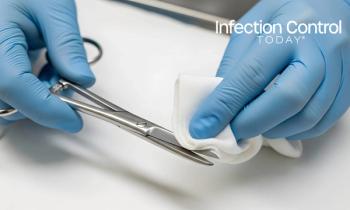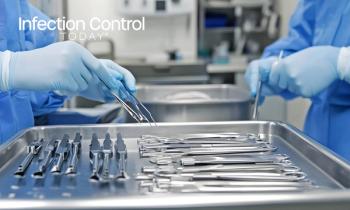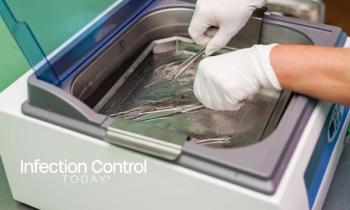
The Challenges Associated with Loaner Instrumentation
By William DeLuca
Loaner instruments, or loaner trays, are defined as trays or instruments not purchased by the facility. Companies often supply specialized instruments for uncommon surgeries (such as spinal and total joint). There are possible challenges that arise with this arrangement. Although loaner instruments remain the property of the vendor, the facility is responsible for paying for its temporary use and maintenance until it is sold by the vendor. As such, facilities must properly manage the cleaning, sterilization and inventory of loaner instrumentation.
Specifically, three groups must collaborate to ensure that proper procedures are in place. The vendor, operating room personnel and sterile processing personnel must work together to maintain inventory and uphold the safety of patients. Given these complicated issues, the management of loaner instrumentation has become a popular topic among healthcare professionals. One important entity is the central sterile supply department (CSSD), which processes, stores, and issues loaner medical instruments. Loaner instrumentation consists of multiple trays and many types of instruments and/or implants. However, the facility may not be educated on the proper care, processing and handling of loaner instruments because they are not as common. Additionally, these instruments may be particularly rare and complex (Sadler, 2012).
According to Rose Seavey, president/CEO of Seavey Healthcare Consulting, LLC and a former director of the sterile processing department at the Children’s Hospital of Denver, says, “Some of these items are very complicated or sophisticated devices that are new to the facility. The concern is usually built around the enormous number of trays CSSD receives and the lack of time they are given to reprocess these trays properly.” (Sadler, 2012). As such, a successful loaner instrument program requires proper communication between personnel to avoid paying for damages and to avoid poor patient care. Loaner instruments must be used and maintained on a set schedule and require appropriate cleaning. In the context of orthopedic and spinal surgeries, multiple loaner instruments are used for one patient. However, challenges may arise if the hospital schedules too many surgeries on the same day. If the schedule fails to account for the time needed to properly sterilize the loaner instruments in between multiple surgeries, then immediate-use steam sterilization (IUSS) can occur. However, many loaner instruments have not been approved or validated for IUSS. When hospitals fail to properly schedule the use of loaner instruments, this can negatively affect patient outcomes.
Vendors can also assist the facilities by ensuring that supplies are properly delivered with enough time before the scheduled surgery to clean and sterilize the instruments. To avoid problems with patient safety, vendors should also provide specific guidelines to the facility. Some facilities require vendors to deliver trays to CSPD 48 hours prior to the scheduled case. This has been a popular topic of conversation in CSPD. Chobin (2015) points to four strategies that can be implemented:
1. Vendors should recommend proper detergents and chemicals that are safe and effective
2. Vendors should provide methods and parameters of sterilization procedures
3. Immediate use sterilization instructions should be stipulated if they have been validated and approved
4. Vendors should provide instructions for proper use
Additionally, Chobin (2015) argues that personnel should ask questions and keep communication open. Importantly, facilities should be attentive of the person(s) or entity reviewing the instructions for use (IFU). Problems may arise if the recommended temperature necessary for sterilization is not approved for practice in the United States, as many instructions for use provide sterilization temperatures that have not been validated for use in the United States. As such, personnel must contact the company to resolve such problems.
Cleaning and decontamination should follow the company’s IFUs, but problems arise when the materials are not provided or available for the facility. There are four components to ensure that loaner instruments are properly cleaned, according to Chobin (2015):
1. Ultrasonic cleaners with extended sonic cycles must be sufficient
2. The facility must possess sufficient washers
3. Loaner instrumentation programs must be sufficiently staffed
4. There must be sufficient capacity for sterilization
If the loaner instruments arrive without sufficient time to process, this can stress personnel and set up conditions in which errors are more likely to occur. When personnel are understaffed, they may cut corners and omit key processing steps. An example of a problem that can occur when a facility does not have access to the loaner instrument’s IFUs is when personnel do not know how to assemble and disassemble components properly, and debris may be trapped inside. Chobin (2015) notes in an example that pieces of bone have been found inside a reamer because the staff did not understand how to connect its individual components, and facilities have had debris delivered in loaner sets that were supposedly sterile. Chobin (2015) recommends that personnel ask specific questions to ensure that sufficient communication and procedures are understood. For example, personnel should ask questions such as:
1. Are the drying methods approved by facility conditions?
2. How old are the sterilizers?
3. What packaging materials are used?
4. What is the facility environment like?
5. Have the loaner trays been weighed, and is that weight within the range for compliance recommendations?
Sadler (2012) reports that Duro and Seavey drafted a policy to improve challenges associated with loaner instrumentation and limited regulatory guidelines. This guidance suggests several problems that need to be addressed within the guidelines:
1. A lack of processing time, which can lead to inadequate processing
2. Insufficient processing staff and capacity being available
3. Inability to ensure that implants can be properly monitored
4. Lack of training for staff on how to process sets and work with complex medical devices
5. Unclear labeling and set identification
6. Inability to ensure that all loaned instruments and implants are accounted for.
These issues leave facilities at greater risk for compromised patient health and safety.
Now, formalized loaner instrumentation programs are needed. The key to effective management of loaner instrumentation, according to Duro and Seavey, is to implement one that includes specific policies and also establishes proper controls in place to manage consignment instruments. Additionally, it is up to the individual facilities to produce and implement formalized, standardized, and concrete system of management for loaner instruments (Sadler, 2012). Specifically, healthcare facilities should have a standardized management system that has been reviewed by institutions like the CSSD, plus the infection prevention and control department, and risk management. Lindsay Evener and Anita Cassell of Robert Wood Johnson University hospital in New Brunswick, N.J., have had great success implementing a variety of loaner tray processes. The “Red Tag, Green Tag Process,” where vendor reps will tag trays ready to be processed with a green tag, and trays that are not ready to be processed with a red tag. Evener and Cassell also make sure vendor reps adhere to the hospitals strict loaner policy guidelines -- i.e., the 48-hour rule, where loaner trays are required to be dropped off in the SPD at least 48 hours prior to the case, loaner forms with all recommended information by International Association of Healthcare Central Service Material Management (IAHCSMM), and tags to accompany each loaner tray with doctors’ name, date of surgery, name of tray, and any other essential information desired, lay on a desk right in front of the entrance to the SPD.
IAHCSMM's Orthopedic Council advises that the following items should be included in a loaner instrumentation program:
1. Requesting loaner instrumentation or implants
2. Time requirements for pre-procedure and post-procedure processing and in-services, as needed
3. Acquisition of loaner items, including a detailed inventory list (preferably with picture)
4. Obtaining FDA-cleared manufacturers’ written instructions for instrument care, cleaning, assembly and sterilization
5. Cleaning, decontaminating and sterilizing borrowed instrumentation by the receiving facility
6. Transporting processed loaner instrumentation to the point of use
7. Post-procedure decontamination, processing and inventory
8. Returning instrumentation to the industry representative
9. Maintaining records and transactions (Sadler, 2012)
Another organization that has addressed the lack of guidelines and regulation in loaner instrumentation is the Association of periOperative Registered Nurses (AORN). Sadler (2012) quotes Lisa Spruce, director of evidence-based perioperative practice at AORN as advising, "There should be a systematic process set up in advance that details the steps in loaner instrumentation, and central sterile processing personnel should know these steps and be aware that manufacturer’s written instructions should be followed. Manufacturers’ instructions should always be followed to assure that the instruments are being cleaned and sterilized properly. It is the responsibility of the healthcare facility to assure that loaned instruments are sterilized before patient use."
Different facilities have varying procedures for the decontamination and sterilization process. In one facility, personnel noted that about five times per month, loaner instrumentation was received that did not include proper cleaning and sterilization parameters (Sadler 2012). According to Seavey, “The first step is to inform your sterile processing department or the staff member who is overseeing sterile processing that you will be receiving loaner instrumentation and what is included in the delivery. It’s important so they can plan their day, so they know that it’s coming, but the most important piece of it is that they can make sure they have the manufacturer’s instructions for use so that they know ahead of time that they are able to follow those instructions. For instance, if the instructions say the instrument must me clean in an ultrasonic cleaner, then you must have an ultrasonic cleaner or else you’re not going to be able to clean those items properly” (Becker’s ASC Review, 2011)
In practice, these issues may place challenges on personnel. Last-minute add-ons, or cases that come unscheduled through the emergency department oftentimes lead into issues as well. The surgeon's office is responsible for reaching out to vendors they plan on using for a case. Frequently, the office fails to contact the vendors, leading to instrument trays showing up a day or even hours before a case, or even worse, not showing up at all. Sadler (2012) quotes an operating room clinical educator at a regional hospital as remarking, "When we are notified that a loaner tray will be coming in for a case, we let the vendor know that they must provide cleaning/sterilization parameters for the items." The educator describes her department’s guidelines for verifying whether a vendor loaner tray was properly completed: “At this time, the staff member is to ensure that we have the appropriate parameters for the item.” And, if a loaner tray arrives without the manufacturer’s IFUs, the personnel contact the company to ensure they know that the tray cannot be processed without the parameters available (Sadler, 2012). Thus, when personnel do not accept incomplete trays from companies, this may encourage them to ensure that the manufacturer’s IFUs are available.
Sadler (2012) points to one sterile processing manager who does not accept any sterile trays from other facilities: "Our policy states that any instruments being brought into the hospital must be signed in a checked by a vendor in the presence of an SPD (staff member) for cleanliness. The instrument must then be cleaned in our sterile processing decontamination area and processed by the staff at this facility.” However, this manager notes that, “We have started requesting that vendors bring in the instructions for use with the instruments, or email us the information. The instructions for use provide the necessary guidelines for the cleaning, processing and handling of the instruments, so we must have them on hand before instruments can be process.” (Sadler, 2012)
Loaner instrumentation has become a prevalent part of healthcare facilities, and continues to increase as facilities work to maximize the efficiency and increasing complexity of surgical instruments and practices. As the use of loaner instrumentation grows, facilities and vendors must work to improve the management of these devices.
William DeLuca has more than 10 years of experience working in sterile processing. Starting as a tech at Saint Vincent's Medical Center in Manhattan to the manager of CSPD at Hoboken University Medical Center, and owner of two CSPD courses in New Jersey and Tennessee. His passion for sterile processing is shown through his leadership and willingness to help and teach others progress and grow in the profession.
References:
Becker’s ASC Review. Loaner instrumentation checklist: 10 steps to follow. July 19, 2011. Accessed at: https://www.beckersasc.com/asc-accreditation-and-patient-safety/loaner-instrumentation-checklist-10-steps-to-follow.html
Chobin N. Sterile Processing University, LLC Best practices in loaner surgical instruments. 2015. Accessed at: http://www.spdceus.com/ceus/pdf/loaner_instrumentation.pdf
Sadler D. On loan: The challenges associated with loaner instrumentation. OR Today Magazine. Nov. 1, 2012. Accessed at: http://ortoday.com/cover-story-the-challenges-associated-with-loaner-instrumentation/
Newsletter
Stay prepared and protected with Infection Control Today's newsletter, delivering essential updates, best practices, and expert insights for infection preventionists.






